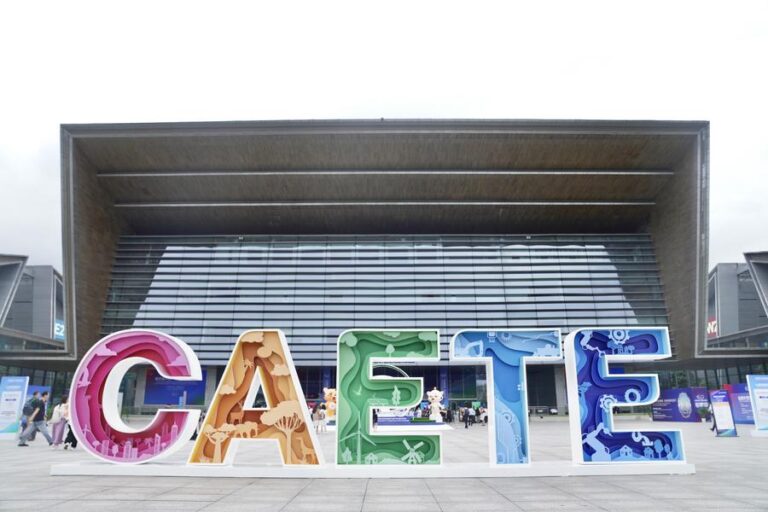* The 4th China-Africa Economic and Trade Expo is expected to further advance the China-Africa partnership in their shared pursuit of modernization.
* Beyond traditional trade, the expo also showcases progress in value-added production between China and African countries.
* This year’s expo features exhibition zones dedicated to clean energy, modern agricultural machinery, along with 30 events to be held in such areas as industrial collaboration and youth entrepreneurship.
by Xinhua writer Zhang Man
CHANGSHA/NAIROBI, June 12 (Xinhua) — The 4th China-Africa Economic and Trade Expo (CAETE) opened Thursday in Changsha, capital of central China’s Hunan Province, drawing a record-breaking of over 30,000 participants from 53 African countries, 11 international organizations and 27 Chinese provincial-level regions, highlighting the dynamic two-way economic ties.
Under the theme “China and Africa: Together Toward Modernization,” the biennial event, running through June 15, aims to further harness the shared development potential as a concrete follow-up to the 10 partnership actions announced at the 2024 Beijing Summit of the Forum on China-Africa Cooperation.
From African flavors to tourism offerings, from digital payment solutions to agricultural machinery and clean energy technologies, the expo is expected to further advance the China-Africa partnership in their shared pursuit of modernization.
BEYOND TRADITIONAL TRADE
At this year’s expo, more than 800 African products, ranging from Kenyan black tea to Congolese framed artwork, are scheduled to either debut or expand their presence in the Chinese market, a stable and promising destination supported by favorable policies and platforms.
The strength of the partnership is reflected in trade data. In 2024, two-way trade reached a record of 295.6 billion U.S. dollars, marking a 4.8 percent year-on-year increase. This solidified China’s position as Africa’s largest trading partner for the 16th consecutive year. Meanwhile, imports from Africa reached 116.8 billion dollars, up 6.9 percent year-on-year.
Beyond traditional trade, the expo also showcases progress in value-added production between China and African countries. One example is Rwanda’s chili sauce, which has become a symbol of integrated value chain development.
Seeking larger-scale and sustainable cooperation, Rwanda’s Gashora Farm partnered in 2024 with Hunan Modern Agriculture International Development Co. Ltd to launch the Rwanda-Hunan Chili Pepper Industry Demonstration Project, which covers 100 hectares (1 square km). The initiative spans the full value chain, from seedling cultivation to export.
In the first season after signing of the agreement, 200 tonnes of dried chili were shipped to China. “The Chinese market offers more than just orders. It brings stability and investment,” said Dieudonne Twahirwa, managing director of Gashora Farm. “It gives us partners. This partnership is transforming our business and the lives of farmers.”
From Kenyan dried anchovies and Madagascan lamb products to rubber from Cote d’Ivoire, cooperation of various forms is expanding across Africa, supporting African countries’ industrialization efforts. This trend has already yielded notable success, including Ethiopia’s Eastern Industrial Zone and the China-Egypt TEDA Suez Economic and Trade Cooperation Zone.
“The continent’s development priorities are shifting from raw material exports to value-added production,” said Humphrey Moshi, a professor of economics and director of the Center for Chinese Studies at the University of Dar es Salaam in Tanzania. “The China-Africa relationship is evolving beyond traditional trade, toward deeper industrial collaboration and shared value creation.”
“It is no longer just about importing, but co-building industrialization,” said Senegalese Minister of Agriculture, Food Sovereignty and Livestock Mabouba Diagne. “China is a strategic partner that can drive the structural transformation of our agriculture … CAETE serves as a matchmaking platform, enabling such win-win collaborations.”
EMPOWERING AFRICAN PRIORITIES
This year’s expo features exhibition zones dedicated to clean energy, modern agricultural machinery, along with 30 events to be held in such areas as industrial collaboration and youth entrepreneurship. The expanded agenda underscores a dynamic partnership aligned with Africa’s priorities, including agricultural modernization, industrialization, and sustainable growth.
“This expo is even more innovative,” said Okonkwo Chinweuba Innocent, Belt and Road Africa Economic Promotion Initiative Center in Nigeria. “It better connects supply and demand between China and Africa … cooperation is expanding into new areas like digital economy, green development and finance,” he told Xinhua.
As cooperation deepens in these fast-growing sectors, Chinese solutions are empowering Africa’s industrialization and modernization, key priorities for the continent.
For instance, in e-commerce, Chinese expertise contributes to local transformation. To tackle persistent logistical challenges, Kilimall, an e-commerce platform founded by Chinese entrepreneurs in Africa, has introduced the “African overseas warehouse” model to reduce delivery time and facilitate cross-border trade. During the expo, the company is showcasing services designed to help entrepreneurs gain access to both Chinese and African markets.
Private-sector participation is also gaining momentum. “I would like to see more Chinese companies set up in Kenya to manufacture solar products,” said Arnold Dodo Kageha, a 28-year-old Kenyan entrepreneur who has profited from distributing Chinese clean energy products such as portable power stations.
“CAETE has become more than just a trade fair,” said Moshi. “It is now a venue through which Africa and China can align their aspirations and work together. It fits squarely within the broader goals of South-South cooperation.”
(Video reporters: Ding Chunyu, Cheng Ji’an, Zhang Nan, Hu Hanbo, Dai Bin, Hao Yilin; video editors: Wang Han, Zhu Cong, Li Ziwei)■

